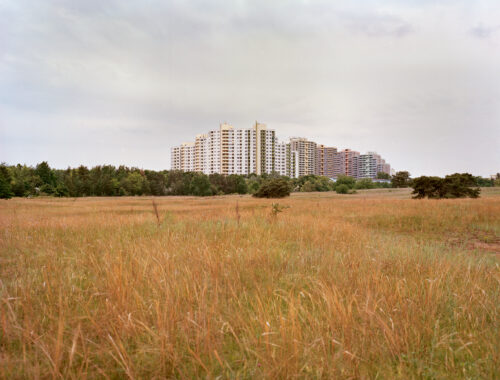
Venissage on 26th January 2024
h 18:00, Protagon Performing Arts space
Is a painting something to be “respected” and “contemplated”? Is the “beauty” of an artwork a universal value that needs to be “admired” and preserved?
We believe that art reflects its times in dialogue with culture and society, it changes with and within them. It is political. And it is not objective, because it is a human production, with all its contradictions. We want art and theatre to be accessible to everyone and go outside the walls of museum and institutional theatre; we aim to put them in relation with the space we leave in, to our neighborhoods, streets and gardens.
For these reasons, Winterwerft aims to bring together artists from different disciplines to collaborate, exchange and share ideas and creative input as well as to create an enriched and safe space where dialogue and reflection can happen. We use unconventional spaces and contexts to rise questions and stimulate an active dialogue with the public and other artists.
The theme of this year is Bodenlos – losing ground, metaphorically, but also practically, we are losing our lands, our soil, our planet, and our heritage. How can art, music and theatre help to raise awareness and stimulate political action in the public?
Within this framework, Losing Ground Gallery offers space to regional, national and international artists* to present and expose their work – paintings, sculptures, film, video art, visual arts, photography and literary works – as well as workshop and performance actions.
This year the thread that connects the artists in our gallery travels in space and time questioning our way of living and treating our places in terms of environment as well as their cultural heritage. Losing ground also means the risk of losing memory of the past as remind us of the project verbrannte Orte with the photo exhibition Burnt Places – Book Burnings of 1933. Do we look at the places differently when we know what happened there? The focus is on photographs from today of the places burned in the past, inviting viewers to engage with the history.
Keeping track of time in a poetical yet concrete way are also the artworks from artist Jule Seibel in which the materials used for paintings are mostly extracted by plants: cabbage, onion, roses, hibiscus and many other natural materials are used by the artist after a handmade process of extraction and preparation. Therefore, the artworks keep the track of this origin and changes in color and rendering with time. Colors fade, vanish and eventually die recalling metaphorically a natural biological process as well as the artificial decay caused by human impact on the planet.
The topic of changing and adapting to the external conditions is present also in the series of installations of Michael Schmidt who challenges the limitations imposed by visible borders. In his drawings the artist tries to capture the life of immigrant people leaving their homeland in search of a better place. With different techniques and styles the artworks are scattered in several places of the festival venue, including outdoor, challenging the conventional notion of art space in museums. In this context the “displaced” artworks mirror and question the status of displaced people in foreign countries.
Daryna Blyshchuk on the other hand will present a performance that addresses directly the topic of home-earth connection and displacement. The performance is the result of impressions and artworks realized and collected during a project called “through”, in which the artist conducted a series of art-therapy intervention in her homeland Ukraine. In this performance, the emotions of an entire nation are thematized: pain and fear, love and the rebirth of the nation, embedded in the feelings in the context of war.
In connection with individual roots is the performance The birth of an utopia by artists Valérie Abeloos and Chiara Zanzi that will take place in the gallery space (see the festival program). In this work they reflect on what happens when we forget our mothers and then we look back at them and rebuild new relationships.
On the fringe between intimacy and public space we find also the video installation of Kemelo Sehlapelo who put on display the process of “wash day” and black hair as an archive of small revolutionary acts. To a world where the dominant narrative is shaped by violent structures and oppressive power the Sehlapelo answers with the creation of small acts of world-making that reclaims a personal narrative: the acts of washing treating, tending her hair as she would tend a garden, a generative ritual that can mirror an alternative gentle way of occupy this planet.
Playing with the mainstream narrative of the world as a “consumable” place criticizing it and yet making the public smile is also the work of Charlotte Rahn, who deliberately puts upside down the allure of the consumer and commodity world and thus point to the effects that these trendy utopias have on our social and ecological structures. The improbably long half-life of plastic makes it a material that gives form to the vision of a possible future for humankind and nature.
Artists
Valérie Abeloos (Belgium) and Chiara Zanzi (Italy)
Darya Blyshchuk ( Ucraine )
Charlotte Rahn ( Germany )
Kemelo Sehlapelo ( South Africa )
Michael Schmidt ( Chile )
Jule Seibel ( Germany )
Verbrannte Orte e.V ( Germany )
Yaryna Kvitka ( Ukraine )
Program
26.01.2024 7PM Vernissage and guided Tour with Artists
31.01.2024 8-10PM Open Atelier Workshop: Valérie Abeloos and Chiara Zanzi “Birth of an Utopia”
02.02.2024 7 PM Performance of Valerie and Chiara “Birth of an Utopia”
02.02.2023 7.30 PM Reading of Verbrannte Orte / Burned Places
07.04.2024 8-10 PM Open Atelier Workshop: Jule Seibel, Plantcolour Painting
09.02.202 6.15 PM Performance of Daryna Blyshchuk “Through”
11.02.2024 3-5PM Open Atelier Workshop for Familys: Jule Seibel, Plantcolour Painting
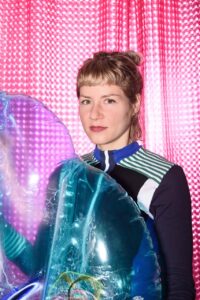 I discovered my artistic interest at a very young age and expressed myself creatively in many different ways. My artistic career began in 2007 at the technical high school for design at Gutenbergschule in Frankfurt. During this time, I realized that I wanted to continue working with art and then worked intensively on an application portfolio for various art colleges in Germany. Before I started my art studies at Hochschule für Gestaltung in Offenbach, I had spent six months in Peru on a social project for orphans.
I discovered my artistic interest at a very young age and expressed myself creatively in many different ways. My artistic career began in 2007 at the technical high school for design at Gutenbergschule in Frankfurt. During this time, I realized that I wanted to continue working with art and then worked intensively on an application portfolio for various art colleges in Germany. Before I started my art studies at Hochschule für Gestaltung in Offenbach, I had spent six months in Peru on a social project for orphans.
There was a studio on-site where I myself worked, as well as supervised art courses for the children and was thus able to gain a lot of valuable experience. During my diploma studies at the HfG Offenbach (2011 – 2020) I was able to try out myself creatively in many ways and develop my own artistic visual language during this time. Working on my diploma was the beginning of a new intensive phase and a further development of my artistic practice. After graduating from HfG Offenbach (2020), several exhibition projects followed, such as my first solo exhibition at the saasfee Pavillon in Frankfurt (2021), as well as the collaboration with the project-based gallery XPINKY in Berlin. In addition, in 2020 I worked with the collective KlimaKriseKlitoris and have already participated in a film, as well as at an art and performance festival in Berlin.
NO PROTECTION AGAINST DROWNING II, 2019 
The work NO PROTECTION AGAINST DROWNING II consists of two rubber rings that have been further processed as sculptural image carriers. Partly still filled to the brim, partly already collapsed and solidified by plaster, the rings tragically and ironically suggest organic features and human postures. In reference to the popular motif of yin and yang, whose Far Eastern exoticism has long been exhausted in its eternal repetition, the unequal pair of twins awaits with overloaded and garishly pop and shrill pop imagery. The mixture of specific symbols and abstract structures refers the viewer to the excessive demands of today’s flood of images. These can apparently only assert themselves as an inflated and at the same time fragile surface.
BLOB ROSS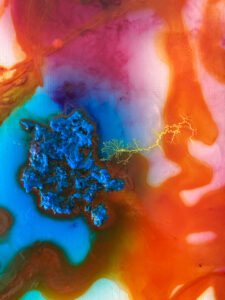
Building on the principle of growth based on the adaptive cycle that all ecosystems go through and which describes the four stages: growth, stagnation, crisis and reorganization, various works of art can be created for this purpose. The Blob Ross series of works and the artistic exploration of the slime mold are particularly well suited to this year‘s festival theme „losing ground“, due to their complex nature and their diverse specific network and utilization systems. Fungi play an important role in all natural processes and thus influence the soil, as well as every basis of existence on planet earth. In this respect, the adaptive cycle is a circulatory system that exists in close connection and cooperation with fungi of all kinds. In turn, plastic plays a key role here as an ambivalent and omnipresent material, as it has long since found its way into people‘s everyday lives through its diverse uses and thus also influences the adaptive cycle.
 In the art practice I am interested in the matter of painting. All matter which is alive, vivid, transformig, moulding, processing, as well as all matter which is emerging in social interactions and in the presence constitute essential moments of my artistic approach. The matter of painting in my art practice is mostly extracted from plant based materials, e.g. from roses, coffee, turmeric, onions, hibiscus, beetroot, red cabbage, blackwood, mushrooms (Tintling), safflower etc.
In the art practice I am interested in the matter of painting. All matter which is alive, vivid, transformig, moulding, processing, as well as all matter which is emerging in social interactions and in the presence constitute essential moments of my artistic approach. The matter of painting in my art practice is mostly extracted from plant based materials, e.g. from roses, coffee, turmeric, onions, hibiscus, beetroot, red cabbage, blackwood, mushrooms (Tintling), safflower etc.
It results in unique appearances on paper, canvases, wood and projections.
The colours stand for specific extractions of plant based material, for certain cooking techniques, for chemical reactions and maturing processes.
Due to the transforming quality of plant materials, the artworks are constantly changing. The experience of looking at the paintings always resumes in singular moments.
Bodenlos – the matter of painting losing its ground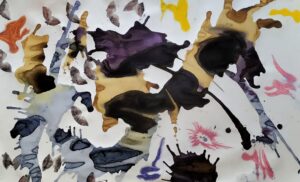
The artworks Lila Gelb Braun 2x Zitrone (Purple Yellow Brown 2x lemon), Schmetterlinge mit Skizzen auf dunkelblauer Landschaft (Butterflies and sketches on dark brown landscapes) and Kaffee Kurkuma Skizzen mit Acryl (Coffee Kurkuma Sketches and Acryl) are steadily losing ground in a way of losing their intensity of colours. The colours fade, vanish and finally die out. Artworks are steadily losing their pigments, too – they just fall of the surface. Each transportation of them includes a high risk of being damaged. So the they react to their usage; in a wider sense, they react to their social environment.
The process of damage and decay involves feelings of loss, humility and melancholy. At the same time, these emotions spur on a continuation in need, they spur on a re-start and re-production of my art practice. Furthermore, losing something also means to quit old (visual) ideas, habits and thinkings. This sheds new light on finding unseen and unexplored artistic ways. While the artworks might lose theirselves, I never lose an artistic approach because I do know well all the techniques to give birth to new things. By the way, the exchange in a community is as important as my individual process in the studio. Without friends, workshop participants, people who are interested,I would not have gained all the ideas and knowledge through my art.
Workshops
Wed 07.02.2024 20-22 h, Protagon Kulturgelände, Halle
Workshop for adults: Painting with plant colors
In this workshop, we will paint with the color juices of various plants on paper. You will get to know a few plants and can experience them with your senses while painting. We will use a few tricks to trigger chemical reactions and change the color and surface. Experimenting, discovering and lingering are very welcome here!
Sun 11.02.2024 3-5 pm, Protagon Kulturgelände, yurt
Workshop for families: Painting with plant-based paints
In this workshop, we will paint on paper with the color juices of various plants. You will get to know a few plants and can experience them with your senses while painting. We will use a few tricks to trigger chemical reactions and change the color and surface. Experimenting, discovering and lingering are very welcome here!
 Kemelo Sehlapelo is a South African dance artist, performer and writer. Calling many places home: Cape Town, Pretoria, Budapest, and now Germany. Her work is marked with making the often shifting invisible inner realities of identity and personhood present through and with movement, voice and text.
Kemelo Sehlapelo is a South African dance artist, performer and writer. Calling many places home: Cape Town, Pretoria, Budapest, and now Germany. Her work is marked with making the often shifting invisible inner realities of identity and personhood present through and with movement, voice and text.
No Small Thing
A home video-style film documenting the process of “wash day” and black hair as an archive. No small thing documents “wash day” as a ritual and a journey of remembrance. Through various conversations, several black women share their hair stories. Our hair is honoured as an ancestral archive of experience.
Made by and with Kemelo Sehlapelo, Nya Bardouille, Princess Ijeoma and Laura Stellacci.
 Michael Schmidt, a Chilean-German artist residing in Frankfurt am Main, emerges as a creator whose early interest in the performing arts led him to explore the realm of acting under the guidance of Fernando Gonzalez’s Theater Club in his native Chile. Despite this initial connection, drawing and plastic arts have been constant companions throughout his life. Despite never formally studying the technical aspects, he possesses a vast expressive potential. It was during his recent years in Germany that Schmidt decided to dedicate significant time to painting, recognizing it as an integral part of his artistic development. His journey across Europe marked the inception of his collection titled ‘Strange Beings,’ a compilation of drawings capturing a diverse array of characters, emotions, and concerns through an abstract style. Through this series, he aims to engage the viewer in a dialogue, challenging the conventional and seeking to open new perspectives in the artistic experience.” Since 2023 he is part of Antagon TheaterAKTion Ensemble.
Michael Schmidt, a Chilean-German artist residing in Frankfurt am Main, emerges as a creator whose early interest in the performing arts led him to explore the realm of acting under the guidance of Fernando Gonzalez’s Theater Club in his native Chile. Despite this initial connection, drawing and plastic arts have been constant companions throughout his life. Despite never formally studying the technical aspects, he possesses a vast expressive potential. It was during his recent years in Germany that Schmidt decided to dedicate significant time to painting, recognizing it as an integral part of his artistic development. His journey across Europe marked the inception of his collection titled ‘Strange Beings,’ a compilation of drawings capturing a diverse array of characters, emotions, and concerns through an abstract style. Through this series, he aims to engage the viewer in a dialogue, challenging the conventional and seeking to open new perspectives in the artistic experience.” Since 2023 he is part of Antagon TheaterAKTion Ensemble.
Seres Extraños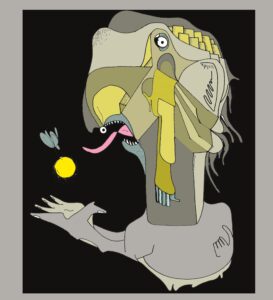
“In an attempt to challenge the limitations imposed by visible borders, these works of art seek their own space in which to manifest themselves. The frames that surround the canvases merely indicate the place where a painting existed, but for various reasons, these works prefer to move and find a new comfort in other environments. By trying to capture the life of immigrants who leave their homeland in search of more favorable conditions, these paintings, representing various surreal beings, explore space leaving only the imprint of their origin (the frame). , taking over spaces that they would never have imagined occupying.
With diverse styles and materials, this collection of works seeks to explore every corner of the environment to be discovered and inhabit the spaces that stand between us. Being only visible beings, they seek to express the artist’s experience in another country up to this moment.
These drawings are found in any nook and cranny of the house, including the exterior, seeking to surprise visitors in their search, challenging the conventional notion of an art space in museums or galleries. These works are designed to resist and be given value through their adaptation to the environment and the response they provoke in the public. It is equally essential to have a space to explain this concept, generating the sensation of an artistic exhibition. Therefore, picture frames must have a specific place for their arrangement.
I consider that this removal of the paintings from their usual place can also be interpreted as a reflection of the movement of people in the world, and how they move from one place to another or lose their roots in foreign soil.”
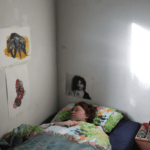 Chiara Ines Zanzi
Chiara Ines Zanzi
Where i’ve grown, mountains are in every corner of the horizon. One of them has the shape of a little triangle, it can be seen through the mist only at certain times of the day. My mother’s name is Annalisa, she used to write stories on the train. Outside of my window there’s a tree, and in the morning there are birds that move in huge storms. I share a room with Laura, Laura knows how to make bread in the oven. My friend Andrea told me he met an old guy in the mountains and they’ve eaten salami together, my friend Emma told me she cried in the bus and a family sat with her, ‘look, now we’re crying too’ they said. I want to be so slow, i want to be slow. I’m tired of being fast and lost. I’d rather be lost and slow.
 Valérie Abeloos
Valérie Abeloos
a mind filled with dreams, thoughts and hope
i discovered hope in a field full of sheeps
sitting right in the middle of this green
rectangle to meditate, a lamb got curious and approached slowly
she smelled me, i said hello softly, and she laid down to sleep on my left knee
it seemed at that moment that she inspired the older sheeps to leave their fear behind and join me
i was surrounded by trust nature inspires me to create, living beings talk and i want to take the time to listen to them like i listen to my own dream.
Birth of an utopia – Paintings 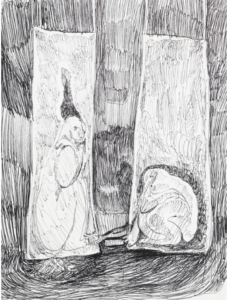
We have forgotten our mothers, the names of the trees… And now that we look at them again, we will create new names and build new relationships from the ones that have been erased and forgotten
Workshop
31.1.2024 20-22 Uhr Protagon Kulturgelände, Halle
The birth of an utopia
“Grounding utopias” is a workshop in which we are going to imagine utopias collectively. We are going to share our desires and root them through painting, writing and storytelling. We will experiment the effects of space on imagination and share practices of urban resistance.
Performance
2.2 at 19:00 Protagon Kulturgelände, Foyer
The birth of an utopia, 15 min
Hidden by two separated squared tents, two creatures start a dialogue. “We need to understand what we need to understand”, they say, they draw pictures to be seen from the hidden eyes of the other. Under their squared tents, they draw.
Hands crawl under the veil, they reach other hands and fill them with things. With voices that safely walk through the veil, and with hands that exchange treasures, from the started dialogue, visions are produced. Utopias grow vividly when absence is created; when rules are suspended, images emerge without hesitations, and when images are created, they quickly call others to come.
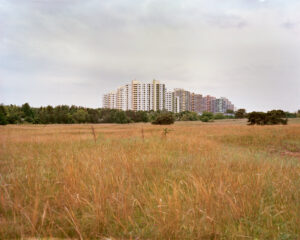 Verbrannte Orte, Orte der nationalsozialistischen Bücherverbrennungen (Burned places, where nationalsocialists burned books) has set itself the goal of contributing to the culture of remembrance.
Verbrannte Orte, Orte der nationalsozialistischen Bücherverbrennungen (Burned places, where nationalsocialists burned books) has set itself the goal of contributing to the culture of remembrance.
Give a face to the places of book burnings, so that they do not Fall into oblivion. How do places look today and how do we look at them differently? Are there any visible signs of the memory of those places, and are local forms of memory work recognizable? These are the questions that the project tackles.
In the course of time an online atlas has been created: Current photographs bring selected perspectives into focus and make the forgotten places of book burnings visible. For this purpose, materials for the local events are collected and regional peculiarities in the actions of the book burnings are clarified. The exact search of the location information, as well as the transfer of the historical in today’s addresses complete the location information. Based on existing academic research, information sources on book burnings are reviewed. The project aims to offer new ways of dealing with historical events and developing a variety of different approaches. In addition to the “digital memory” also include exhibitions, lectures and the promotion of local memory work.
Verbrannte Orte / Burned Places
Just three months after coming to power, the National Socialists began practicing intimidation. One highlight was the compilation of the “List of the Un-German Spirit”, which included 131 authors. Books by these authors were burned in public places in more than 20 cities on May 10, 1933. This became known as the “Action against the un-German spirit”. This action and the burnings were centrally organized by the German Student Union. In addition to the systematic and centrally organized burnings, there were other book burnings in many places, which were organized by local actors.
There is hardly a visible reminder in any place today. Many people know that there were book burnings in Germany, but often only know about the burnings as part of the “Action against the un-German spirit” and here again mostly only the ceremonial burning on Bebelplatz in Berlin. The majority of the more than 160 burnings are hardly known to the general public.
Do we look at the places differently when we know what happened there? This question is the focus of the exhibition “Burnt Places – Book Burnings of 1933”. The focus is on photographs from today of the places burned in the past, inviting viewers to engage with the history. The photographs are complemented by background information on the National Socialist book burnings, Nazi literary policy and the authors concerned. With a focus on democracy and freedom of expression, the exhibition combines history with today’s commitment. There were over 160 book burnings in Germany at the time, only a few of which are still known today – a good reason to take a closer look at this part of history.
Book Reading
02.02.2024 ca. 19.30 Protagon Kulturgelände, Foyer
“Verbrannte Orte/ Burned Places” in German
Do we look at the places differently when we know what happened there? This question is the focus of the exhibition Burnt Places – Book Burnings of 1933. The focus is on photographs from today of the places burned in the past, inviting viewers to engage with the history. The photographs are complemented by background information on the National Socialist book burnings and the authors involved. There were over 160 burnings in Germany at the time, only a few are still known today, a good reason to engage with this part of history.
 Daryna Blyshchuk, born in Ukraine, began her artistic journey at an art school in Kyiv, where she fell in love with the power of art. She lived in Ukraine as an artist for many years before coming to Wiesbaden three years ago to study media and moving image studies. Having lived through the first years of the war in her home country, she organizes many voluntary events in Ukraine and spreads her anti-war ideas in Germany.
Daryna Blyshchuk, born in Ukraine, began her artistic journey at an art school in Kyiv, where she fell in love with the power of art. She lived in Ukraine as an artist for many years before coming to Wiesbaden three years ago to study media and moving image studies. Having lived through the first years of the war in her home country, she organizes many voluntary events in Ukraine and spreads her anti-war ideas in Germany.
Her artistic career is characterized by a deep connection with home and earth, with the spirit and the sky. This connection between art and nature allows her to explore stories in innovative and captivating ways.
She is particularly fascinated by theater as a powerful form of creative and spiritual connection. In her work, she strives to explore the diversity of human emotions and build bridges between different worlds and people through art.
Through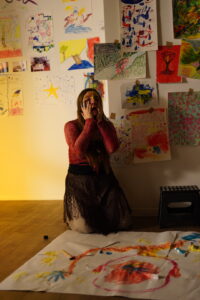
In a haunting panorama of the human soul, the exhibition of “Through, Наскрізь, Hindurch” tells stories marked by deep emotions, war scars, love, joy, the inner child and deep thoughts.
The works, created by people aged 7 to 60 from Ukraine, reflect the diversity and richness ofhuman experience.
The artistic odyssey began in the western climes of Terebovlia and led through the vibrantstreets of Kyiv to the southern sites of Tuzly and Dywisija. In the classrooms, forest clearings and creative spaces, the individual narratives unfolded, inspired by a wide range of emotions highlighted by the artist in the therapy workshops.
The participants of this creative expedition, animated by freedom, designed their works duringthe art therapy workshops, curated by Daryna Blyshchuk with some quided spiritual meditations and live instruments. From powerful brushstrokes to delicate shading, from colorful explosions to soft accents – each work tells an individual story of different human beings.
No limits were set, neither in the choice of medium nor in the form of expression. The artists had the choice of taking their artworks home with them or keeping them for future exhibitions. Anonymity or personal inscription, the decision was left to the creators. This exhibition, a gallery of human diversity and expression, invites you to immerse yourself in the individual stories written through art. A reflection of human emotion affected by ongoing life during the War, powerful and unadulterated, is revealed in every brushstroke and nuance of color, in each shape and figure.
Performance
Fr 9.2.2024 7 pm Through 45 min.
“In order not to feel my own pain, I decided to feel the pain of my brothers and sisters, to feel it through and through…”
The “Through” project was born out of a pressing need to take action and help the homeland, both locally and internationally, to transform people’s pain through art.
During the summer vacation, a cycle of art therapy was carried out in various cities across four different regions of Ukraine, illuminating the emotional facets of people. The name of the project, “through”, reflects the process in which people’s images are fully felt through the soul, body and mind.
After selecting 14 images that left a deep impression, Daryna created an impressive art performance. In this performance, the emotions of an entire nation are thematized: pain and fear, love and the rebirth of the nation, embedded in the feelings in the context of war. The image of a nation is created from individual strokes, folds and sounds.
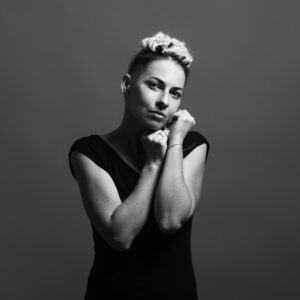 I am a performer, singer, visual artist and travel vlogger. Since 2009, as a leader-vocalist, I have been singing Ukrainian traditional songs in my band Folknery, which is well-known in Ukraine, with numerous performances in many countries around the world (Europe, Asia, Australia). I have mastered the technique of traditional Ukrainian folk singing, which is called “white voice”. I also play some musical instruments (such as jew’s harp and percussion).
I am a performer, singer, visual artist and travel vlogger. Since 2009, as a leader-vocalist, I have been singing Ukrainian traditional songs in my band Folknery, which is well-known in Ukraine, with numerous performances in many countries around the world (Europe, Asia, Australia). I have mastered the technique of traditional Ukrainian folk singing, which is called “white voice”. I also play some musical instruments (such as jew’s harp and percussion).
As a performer, I have significant experience in participating in performances of several theaters, both Ukrainian and European. My main acting discipline is physical theater. I finished MAPA (The Moving Academy for Performing Arts) in 2010. In Jan 2012 ‐ May 2012 I worked as a performer with I.T.PER theatrical troupe ‐ Ukraine/France. We did performance “Live”. I also performed in Theatre “KROT” and First Woman’s Theatre.
In Feb 2023 I performed in theatre festival “Winterwerft” in Frankfurt, Germany. I took part in collaborative performance «PHOENIX».
As a visual artist, I have been practicing graphic drawing techniques since 2019. I participated in several collaborative exhibitions and had my personal exhibition “Motherhood” in Scotland.
Through my art, I try to find and give answers to my own deep feelings, what home is for me, how deeply I feel my roots, why motherhood has such an impact on my consciousness. In my art I broadcast my own feelings, who I am as a woman. Since 24th February 2022, when Russia attacked Ukraine, in my art I depict pain more and more. I, as an artist who has traveled through 36 countries on a bicycle, who has seen with my own eyes the environmental problem in the
world, has seen how we are destroying our Planet, this question hurts me a lot. But the question of my own ecology of thoughts, which, unfortunately, are often destructive because of the war, because of the loss of the previous life, before the war, hurts me no less. So, I reveal all my feelings in art. And mostly it is difficult to put into words.
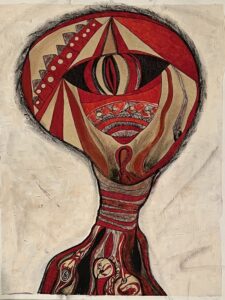
Picture “ The keeper of her own roots and memory of the tribe” was created in 2023 in Hexham in the UK, where I live now because there is a war in my country. The picture is from the series “Motherhood”.
On February 24, 2022, when Russia attacked Ukraine, my life turned upside down. The processes of grieving, grief and pain began. The processes of thinking about belonging to the tribe, as the basis of me, also began. I delved into myself in search of memorable elements of self-identification. I am a Ukrainian woman who was plucked like a flower and moved somewhere else. My roots have lost the soil from their native land, but they have not lost the memory transmitted with mother’s milk. I carry my language, traditional songs, I remember history, I remember my childhood and youth stories, I remember the smells and colors of my country, I remember cold winter mornings, I remember the flowers in the field where my grandmother lived, I remember my family and friends. We are far apart now, but I try to keep the best of what I had. I look at my thoughts and feelings and often ask if I can hold them without their native soil…
I know for sure that our Ukrainian victorious and revolutionary colors are black and red. They are the ones that impress me the most this year. Black is grief, and red is love.
I’m a fragile flower that hurts a lot because instead of coming together and saving our planet, we’re killing each other and creating wars.
Media I used to create this picture: paper, ink, acrylic, pastel oils.
Size: 56×76 sm


